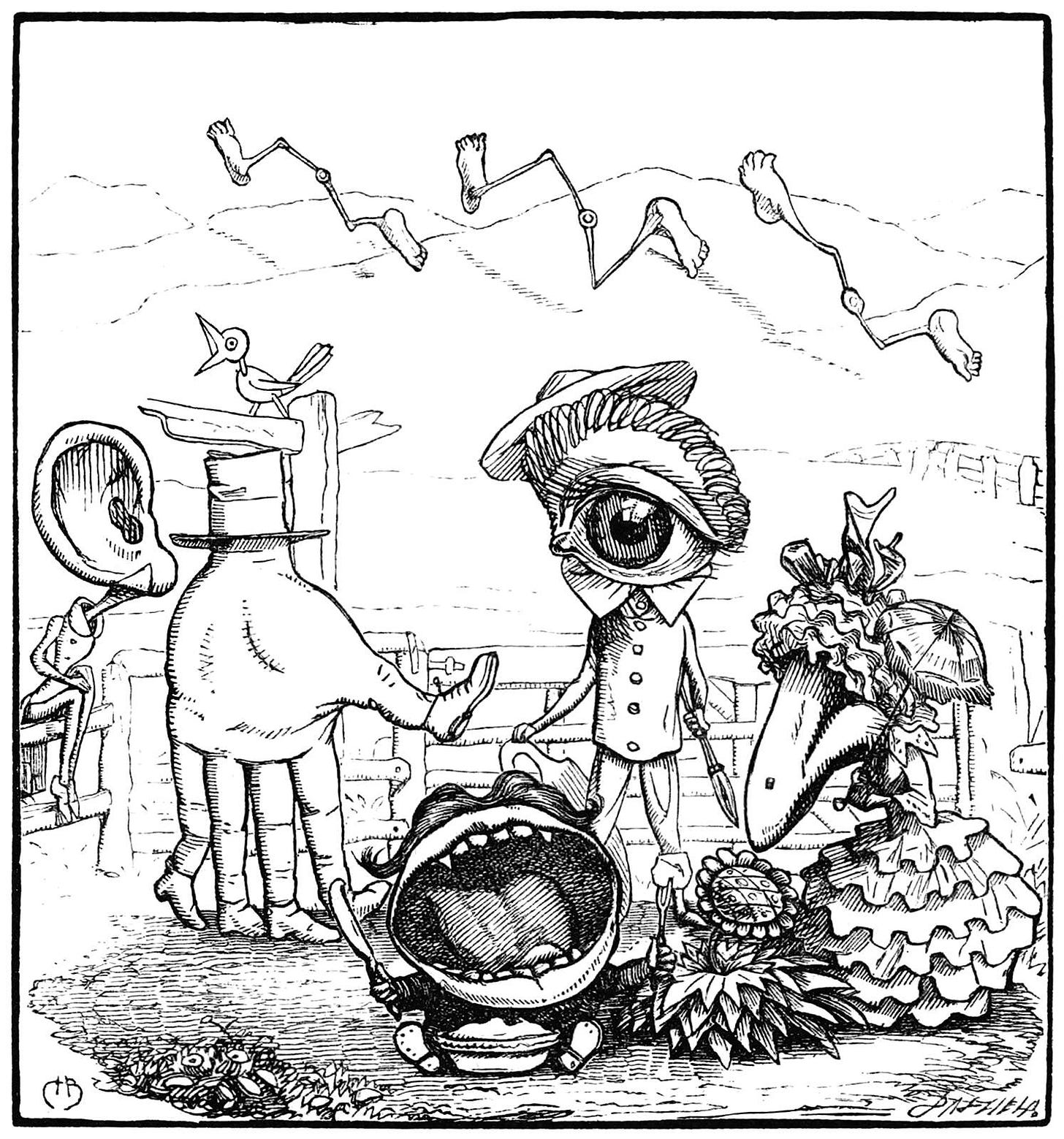Getting Started
A whirlwind of opinions and lists and lists of opinions
What is it we’re starting, exactly? We’re starting our journey together into food, to make it less complicated. We’ll shop for groceries, prep food, cook it, and, most importantly, shove it into our mouth holes. As a rule, my first step is to contextualize. Over time, you’ll find this habit insufferable.
Everyone has an element of their relationship with food they would like to change. It may be something you are actively working on, or one of those things that is filed in the “One Day I’ll…” folder in your mind. It’s worthwhile, as they say in yoga, to set your intention when it comes to reading essays like this so they’re most beneficial. Here are a few ready-made statements of intent that you can adopt as your own if you like. Think of these as really comfortable glasses you’ll be wearing for the rest of your journey; these statements are the lenses through which you’ll interpret or misinterpret all my words from here on out. Or if you don’t care about having a solid motivational foundation for this journey and you just want to stumble haphazardly down the path that’s fine too.
Choose Your Food Glasses
- I want to learn a few basics about cooking so I don’t go out to eat as often, i.e. I’m not convinced I can do this but, whatever, let’s try it.
- I want to change the way I eat because my current habits make my tummy sad, i.e. I don’t want to get butt sick every day at work because it’s loud and embarrassing.
- I want to change the way I shop for groceries by learning about where my food comes from, i.e. I want to buy eggs from the happy chickens.
- I’m already pretty good at everything but I’m skimming this for helpful hints, i.e. I have already stopped reading this.
- I don’t want to change anything and I think you’re a moron, but I’m reading this so I can rip you apart on Twitter.
I don’t really care which pair of goggles you’ve chosen, this isn’t choose your own adventure. I’m still going to write the same words I was going to write, but that was just a good exercise to get you ready to interpret the words in the way that works best for your purposes. Which is already what everyone does anytime they read anything.

My Food Glasses
Since I made you choose a pair of food glasses, it’s only fair that I talk a little bit about the ones I’m wearing. My current specks would be better described as bifocals: I’m trying to get better at cooking and I’m also learning more about where my food comes from. I’ve spent lots of time on the Internet finding recipes that suck and wasted lots of money buying cookware I don’t need, but I’ve finally found my groove and outfitted my kitchen with stuff I actually use. Now that I feel more confident in what I want to cook and how, I’m shifting my focus to cooking and shopping better.
I’ve decided the Internet is a good place for cooking inspiration but a bad place for cooking instructions. I prefer to use a cookbook recipe instead of a blog because I assume cookbooks are subject to some sort of editorial review process and blogs are probably not. A cookbook theoretically has to pass the taste test of several people before making it to the bookshelf. I don’t know if a food blogger has ever cooked the recipe on their site because I don’t have time to read 2500 words about their latest family vacation before seeing one word about the recipe. (Side note: I’m also unsure if the star chefs on TV actually write any of the recipes on Food Network’s blog, does anyone know?) The point is I think cookbooks are more reliable than blogs. I’ve tried some bad cookbook recipes, but those seem more rare than bad blog recipes.
While the Internet might not be the best place to find recipes, it’s a great resource for understanding the increasingly complex and opaque network of food sources. A close second would be documentaries, but I’m hesitant to put too much stock in those without researching the folks making the documentary; you never know if they’re being funded by competitors to whatever company they’re claiming to blow the whistle on.
Let’s move on. The next step in our journey: I’m going to assume your main goal is to eat food, so let’s start with buying some.
Grocery Shopping 101
There are millions of words written about the best way to budget, and yet most people still don’t do it. Some of my friends think it’s a little crazy and a lot unnecessary that my wife and I discuss our budget every month and track every penny we spend. But budgets are absolutely necessary–especially when it comes to food–because if you buy whatever you think you want without doing any planning, you’re going to run out of cash and are going to get stuck.
I’m not going to help you create your household budget, I’m just going to tell you, command you, to create one immediately and get your shit together. If you’ve made it this long without a budget, it’s only a matter of time until you dig yourself into a gaping financial hole or until you get married and your partner realizes that you don’t have one and the two of you have very intense, very loud discussions about whether or not he or she made the right decision to marry you.
Therefore, step one is: create a grocery budget. Even if you refuse to get the rest of your life in order, figure out how much you’ve been spending on groceries each month and make a best guess at how much you need. I would also recommend looking at how much you spend on going out to eat.
If you’re not tracking your spending on anything in any way, give yourself a runway here to get it right. Track food purchases for a month, and break them into two categories: Groceries and Restaurants. You’ll adjust this constantly, because if you’re wanting to cook more, then you’re going to spend more on groceries. As you get better at cooking, you’ll do it more often, which means your grocery budget will keep creeping upward while your restaurant budget (hopefully) trends downward.
Step two: always make a grocery list. Do not go in there without a list, and definitely do not go in there without a list and hungry. But wait, you exclaim, how am I going to make a list if I don’t know what I’m supposed to be buying?! The biggest obstacle to cooking your own food: you don’t know what to buy because you don’t know what you want to make.
After trying many different approaches to making grocery lists, I’ve settled into a routine that works well for me. Tweak it to make it work for your schedule.
Schedule Dinner Nights
Every Saturday morning before I make my list I look at our calendar to see how many nights we’ll both be at home that week for dinner (this step became useless for most of 2020). That matters for a couple of reasons: one, we have a kid. It’s really difficult to cook for yourself while a kid yells at you; if I have someone or something (Daniel Tiger) entertaining kiddo while I slice and dice we’ll eat before 9pm. And two, it helps me decide how many nights we need to eat leftovers or go out to eat so that I can pick meals that have leftovers if I need to, or not buy food that will go to waste if I think we’ll be eating at restaurants more often than usual that week.
I pick the nights I plan to cook dinner. I’ve create calendar events for those nights once I’ve decided what we’re having in case there’s advance prep.
Stock Check
I take note of all those staple items (staple = normal stuff you always have around). Then I know what needs to be replaced or refilled, and then I don’t have to make several short trips to the store later that week. The list starts with staples.
Finding Recipes
Time to grab the cookbook. I have a framework for how I build dinners, but I’ll cover that later. It’s important to add the ingredients to the list at home so I can check the status of various spices and oils to make I’ve got everything I need.
Organize (For Speed)
This step is a little extra, and by ‘extra’ I mean it’s something that isn’t necessary but it does save time. I organize the items on the list based on when I’ll encounter them at the store. Yes that sounds silly, but it saves time because I don’t wander around stores as much. This is something Amanda always does with her lists that I’ve adopted because it is smart and I know efficiency makes her happy.
Hopefully some piece of the structure I’ve described is useful to you as you plan your grocery list. Next week I’ll write about how to level up your kitchen to make cooking enjoyable.
I’ve also decided to add some other links to the end of each issue. If you happen to subscribe to the other newsletter I write with my buddy Brian, you’ll know I do most of my reading online and love sharing. Here’s the read for this week (thanks to JD for the link):
A fascinating article from 2012 by an economics professor detailing his rules for dining out. You should also watch the embedded video to remind yourself of how production values of online content have changed in the last decade.
This article is partly interesting to me because of the author’s voice and tone. He’s so matter-of-fact and didactic, and it reminds me of Rick Steves (in a good way). And, now I’m craving Vietnamese food.
